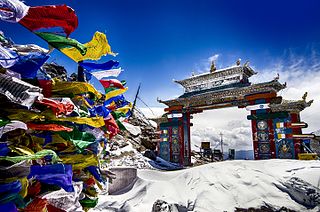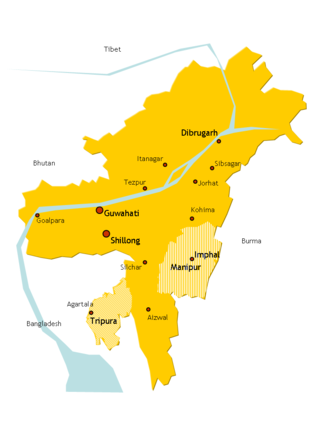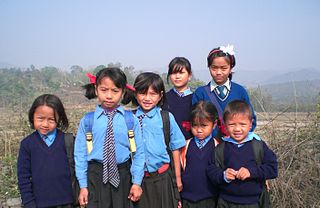
Northeast India, officially the North Eastern Region (NER), is the easternmost region of India representing both a geographic and political administrative division of the country. It comprises eight states—Arunachal Pradesh, Assam, Manipur, Meghalaya, Mizoram, Nagaland and Tripura, and the "brother" state of Sikkim.
Mizo Union was the first political party in Mizoram, northeast India. It was founded on 6 April 1946 at Aizawl as the Mizo Common People's Union. At the time of independence of India from the british rule in india in 1947, the party was the only political force in the Lushai Hills. It won the first Mizoram District Council general election under the new Indian Union in 1951, and consecutively in 1957, 1962 and 1966.
The Hmar language belongs to the Mizo language branch of the Sino-Tibetan family of languages. The speakers of this language use Mizo language as their second language (L2).

The Mizo people, historically recorded as the Lushais, are an ethnic group native to the state of Mizoram in India and neighbouring states of Northeast India. They speak the Tibeto-Burman language of Mizo, the official language and lingua franca of Mizoram. The state is the second most literate state in India, at more than a rate of 90%.
The Paite people are an ethnic group in Northeast India, mainly living in Manipur and Mizoram. The Paites are recognized as a scheduled tribe in these two states. They are part of the Kuki-Zo people, but prefer to use the Zomi identity. "Guite" is a major clan of the Paite people.

The history of Mizoram encompasses the history of Mizoram which lies in the southernmost part of northeast India. It is a conglomerate history of several ethnic groups of Chin people who migrated from Chin State of Burma. But information of their patterns of westward migration are based on oral history and archaeological inferences, hence nothing definite can be said. The recorded history started relatively recently around the mid-19th century when the adjoining regions were occupied by the British monarchy. Following religious, political and cultural revolutions in the mid-20th century majority of the people agglomerated into a super tribe, Mizo. Hence the officially recognised settlement of the Mizos became Mizoram.

The Kuki people are an ethnic group in the Northeastern Indian states of Manipur, Nagaland, Assam, Meghalaya, Tripura and Mizoram, as well as the neighbouring countries of Bangladesh and Myanmar. The Kukis form one of the largest hill tribe communities in this region. In Northeast India, they are present in all states except Arunachal Pradesh. The Chin people of Myanmar and the Mizo people of Mizoram are kindred tribes of the Kukis. Collectively, they are termed the Zo people.
The Hrangkhawls are the subtribe of the Kuki community(one of the kindred tribes of Kuki people community).They speak the Hrangkhawl dialect of Kuki language which is of Tibeto-Burmese origin.They are listed as one of the 21 scheduled tribes of Indian state Tripura. They are mainly dwelling in the Teliamura sub-division of West Tripura and the Ambassa sub-division of Dhalai districts. The Hrangkhawls are also found in the North Cachar Hills of Dima Hasao district, Assam,Mizoram,Manipur and Myanmar.
Zo is a Northern Kuki-Chin-Mizo language originating in western Burma and spoken also in Mizoram and Manipur in northeastern India.
The Halam community are various tribes native to the state of Tripura in India. The name Halam was coined by the Tipra Maharaja. As per their oral tradition they called themselves "Riam", which literally means "Human being". And lyrically they also call themselves "Riamrai, Chepvon, Reivon, Longvon etc.". The Halam are further divided into 12 sub-tribes, namely Sakachep, Chorei, Molsom, Hrangkhol, Kaipeng, Kalai, Ranglong, Thangachep, Bongcher, Korbwng, Dab and Rupini.

The Aimol people are an ethnic group living mainly in Manipur and in parts of Mizoram, Tripura, Nagaland and Assam,Meghalaya in India. They speak Aimol language which is a Kuki-Chin language. They identify themselves as 'Aimol' an independent tribe with no affiliates. Aimols have continued to live in harmony with neighboring communities before the independence and to this day. Aimols are closely related to Kom, Koireng, Chiru, Chothe,khelma,Biete,Biate etc. They use Meitei language as their second language (L2) according to the Ethnologue.
The Kuki-Chin-Mizo languages are a branch of the Sino-Tibetan language family spoken in northeastern India, western Myanmar and southeastern Bangladesh. Most notable Kuki-Chin-speaking ethnic groups are referred to collectively as the Zo people which includes: the Mizo of Mizoram, the Kuki of Manipur, Assam, Nagaland, Tripura and Bangladesh and the Chin of Chin State, Myanmar.

The Zomi Revolutionary Army (ZRA) is an armed Zomi nationalist militant group formed in 1997, following an increase in ethnic tensions between the Kuki people and the Paites tribe in Churachandpur district of Manipur, India. Its parent organisation, the Zomi Re-unification Organisation, was founded in April 1993.
The Zo people is a term to denote the ethnolinguistically related speakers of the Kuki-Chin languages who primarily inhabit northeastern India, western Myanmar, and southeastern Bangladesh.

The Biates are an ethnic hill tribe of Assam, Meghalaya, Mizoram, Tripura and Manipur. Their language belongs to the Tibeto-Burman family. Spread over many parts of North-East India, they have a unique identity with a rich and distinctive history, culture, dialect and religious heritages. They are one of the oldest hill tribes of North East India especially among the Chin-Kuki-Mizo people. The term Biate comes from the word Bia-te. The word ‘Bia’ or ‘Biak’ means ‘speak’ or ‘worship’. ‘Te’ is a suffix denoting plurality. Hence, the two words combine to form the word Biate, which means worshipper.
Sakachep also known as Khelma, is a Central Kuki-Chin-Mizo language of Northeast India. Dialects are Khelma, Thangachep, and Sakachep (Ethnologue). VanBik (2009) classifies Sakachep as closely related to Aimol, Anal, Chiru, Kharam, Koireng(Koren), Kom, Lamkang, Purum, Biate, Chorei, Ranglong, Molsom, Hrangkhol, Kaipeng, Bongcher and Thiek-Hmar.

Aimol, also known as Aimual, is a Sino-Tibetan language spoken by the Aimol people of Manipur, India. It is considered endangered and has less than 9,000 speakers worldwide as per 2011 census. The speakers of this language use Meitei language as their second language (L2) according to the Ethnologue.
Zomi is a collective identity adopted some of the Kuki-Chin language-speaking people in India and Myanmar. The term means "Zo people". The groups adopting the Zomi identity reject the conventional labels "Kuki" and "Chin", popularised during the British Raj, as colonial impositions. Even though "Zomi" was originally coined as an all-encompassing identity of the Kuki-Chin-speaking people, in practice, it has proved to be divisive, with considerable number of groups continuing to use the traditional labels "Kuki" and "Chin" and only certain sections adopting the Zomi identity. The groups covered in the identity has varied with time. Compound names such as "Kuki-Zo" and "Zomi Chin" are sometimes used to paper over the divisions.

The Tuivai River is a river that originates in Myanmar and flows through the states of Manipur, Mizoram and Assam in India. It is the longest tributary of the Barak River, into which it flows at Tipaimukh near the village Sipuikawn.

The hill tribes of Northeast India are hill people, mostly classified as Scheduled Tribes (STs), who live in the Northeast India region. This region has the largest proportion of scheduled tribes in the country.











